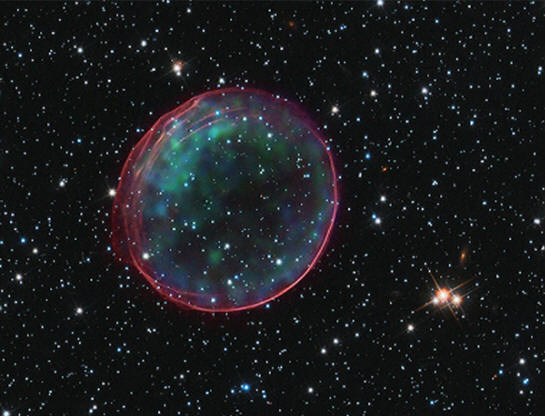|

Supernova Remnant 0509: X-ray in
blue and green, optical in red.
Credit: X-ray: NASA/CXC/SAO/J.Hughes
et al, Optical: NASA/ESA/Hubble
Heritage Team (STScI/AURA)
The Ornament Not Seen
Jun
09, 2011
This image of the Christmas
Ornament nebula in the Large
Magellanic Cloud looks the same to
Electric Universe and Gravity
Universe proponents alike. Their
radically contrary descriptions of
what it is result from their ideas
about what they don’t see.
Gravity Universe proponents
describe a star that
exhausted its thermonuclear fuel and
exploded. It blasted its outer
layers into a rarified interstellar
gas, generating spherical shock
waves that compressed and heated the
gas to the extent of emitting
x-rays. They call the nebula a
supernova remnant.
It helps to know ahead of time
that they’re looking for spheres
because, at that distance,
everything looks flat to the human
eye. They don’t see depth. Depth is
constructed from the assumptions and
calculations of some theory. It also
helps to know ahead of time that
they’re looking for hot gas because,
at that distance, they can’t stick a
thermometer into it. Temperature is
constructed similarly to depth. So
it is with most of the other
elements of the description.
Electric Universe proponents
describe an
hourglass-shaped z-pinch in a
galactic Birkeland cable—a tubular
configuration of current filaments
rotating around an axis. Such a
configuration is the “wiring
harness” of all stars, which is
usually invisible. In stars that are
under heightened electrical stress,
the plasma in the harness is pushed
into glow mode and emits optical and
x-ray light. Z-pinches viewed down
the axis—as is this one—appear as
rings. From the side, they appear as
hourglasses, and from other angles
they may appear as entangled
circles or even as
squares.
The red sheath around the outside
of the cable, excited to emit
optical light, appears as a ring.
The brighter region at upper left is
where the electrical stress is
greatest. Significantly, a
diocotron instability—the
curlicue bend in the ring—is
developing there.
The inner filaments, in which
current carriers spiraling in the
magnetic field emit x-ray
synchrotron radiation, appear as the
26 x-ray “spots.” The number 26 is
typical in electrical discharges in
plasma—which is the Electric
Universe description of stars. They
tend to pair up—as seen especially
in the “hot region” at upper left.
Another characteristic feature of
such glow mode cables is the braided
appearance of the ring currents.
Also, the ring is actually two
concentric rings but with only half
of each emitting light—the outer one
at upper left, the inner one at
lower right. A similar configuration
exists in the auroral circuit around
Earth’s poles: the luminous half of
each ring corresponds to current
flowing in one direction; the dark
half to current flowing in the
other.
It helps to know ahead of time
that they’re looking for 26 spots
because the x-ray image is not all
that clear. They don’t see 26.
Differentiating the several pairs of
spots and the occasional single one
is constructed by analogy with lab
experiments and repeated
trial-and-error counting. It helps
to know ahead of time that they’re
looking for concentric rings of
current because they can’t stick an
ammeter into them. Current flows are
constructed similarly to paired
spots. So it is with most of the
other elements.
The important observation (for
this essay) is what’s not seen. If
explanations were limited to only
what’s seen, they would make little
sense. Sensation (data) gives only
glimpses: a theoretical model
composed of things not seen provides
context, a bigger picture, that
enables us to do things, or at least
to do more things and new things.
Mere facts tend to be merely
confusing.
The sprockets of a theoretical
model into which the cogs of facts
can fit animate the machine. Because
cogs and sprockets can be fit
together in more than one way, we
have the opportunity to see and to
do new things. The choice of a
model, then, as Karl Popper and many
others since have claimed, is a
decision directed by what we want to
do.
Mel Acheson
 New
DVD New
DVD
The Lightning-Scarred
Planet Mars
A video documentary that could
change everything you thought you
knew about ancient times and
symbols. In this second episode of
Symbols of an Alien Sky, David
Talbott takes the viewer on an
odyssey across the surface of Mars.
Exploring feature after feature of
the planet, he finds that only
electric arcs could produce the
observed patterns. The high
resolution images reveal massive
channels and gouges, great mounds,
and crater chains, none finding an
explanation in traditional geology,
but all matching the scars from
electric discharge experiments in
the laboratory. (Approximately 85
minutes)
Video Selections
Order Link
|





 New
DVD
New
DVD

